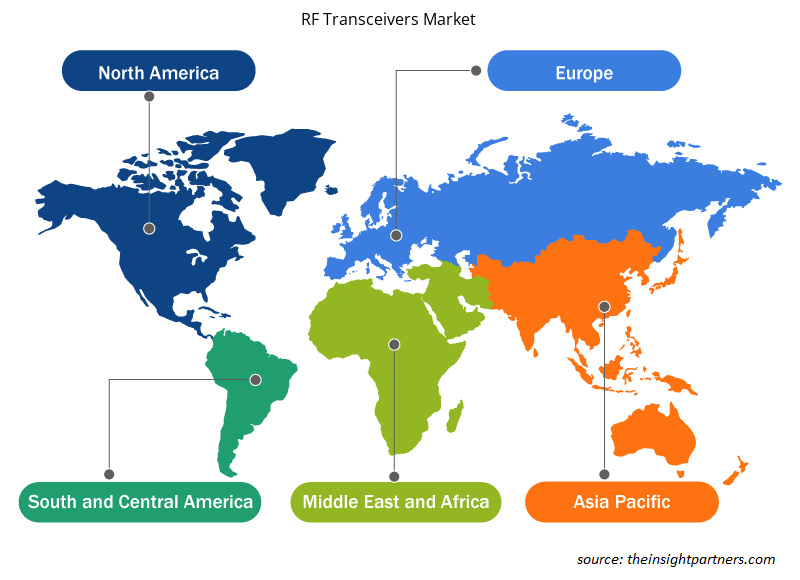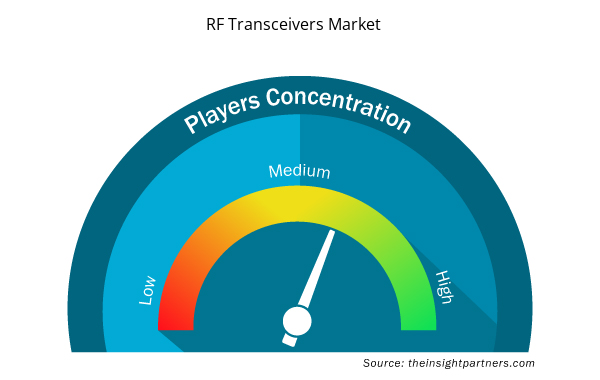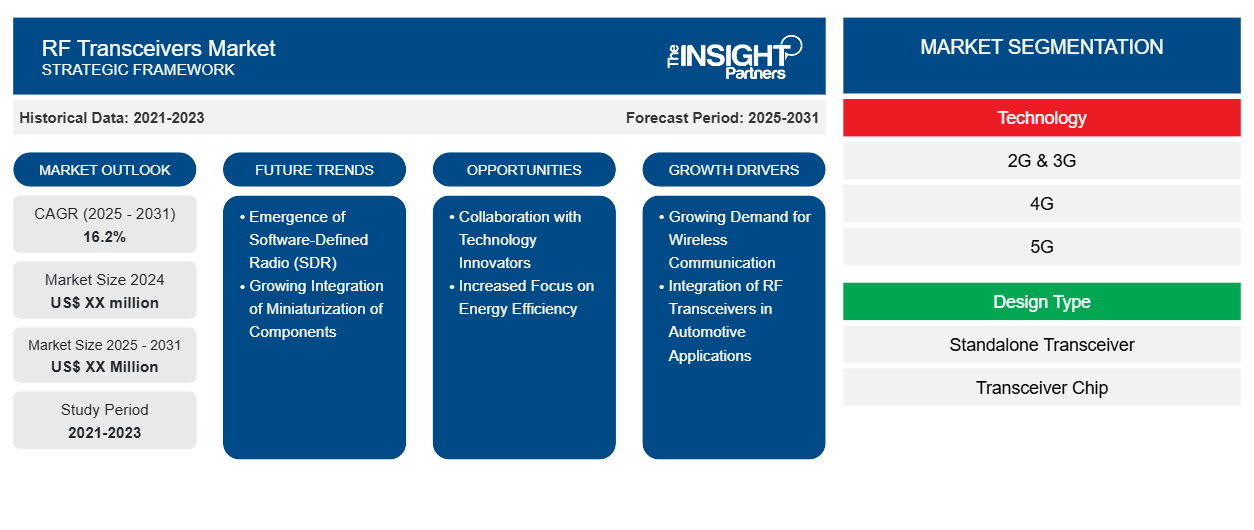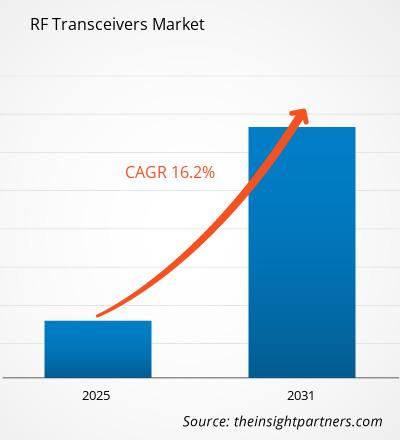Se espera que el mercado de transceptores de RF registre una CAGR del 16,2 % entre 2023 y 2031, con un tamaño de mercado que se expandirá de US$ XX millones en 2023 a US$ XX millones en 2031.
El informe está segmentado por tecnología (2G y 3G, 4G, 5G y otros), tipo de diseño (transceptor independiente y chip transceptor), aplicación (sistemas de comunicación inalámbrica, sistemas de comunicación por satélite, sistemas automatizados, sistemas de seguridad y otros) e industria del usuario final (telecomunicaciones, aeroespacial y defensa, automotriz, automatización y seguridad y otros). El análisis global se desglosa aún más a nivel regional y por países principales. El informe ofrece el valor en USD para el análisis y los segmentos anteriores.
Propósito del Informe
El informe RF Transceivers Market de The Insight Partners tiene como objetivo describir el panorama actual y el crecimiento futuro, los principales factores impulsores, los desafíos y las oportunidades. Esto proporcionará información a diversas partes interesadas del negocio, como:
- Proveedores/fabricantes de tecnología: Para comprender la dinámica cambiante del mercado y conocer las oportunidades potenciales de crecimiento, lo que les permitirá tomar decisiones estratégicas informadas.
- Inversionistas: Realizar un análisis exhaustivo de tendencias sobre la tasa de crecimiento del mercado, las proyecciones financieras del mercado y las oportunidades que existen en toda la cadena de valor.
- Órganos reguladores: Regular las políticas y vigilar las actividades del mercado con el objetivo de minimizar los abusos, preservar la confianza de los inversores y defender la integridad y la estabilidad del mercado.
Segmentación del mercado de transceptores de RF
Tecnología
- 2G y 3G
- 4G
- 5G
- Otros
Tipo de diseño
- Transceptor autónomo
- Chip transceptor
Solicitud
- Sistemas de comunicación inalámbrica
- Sistemas de comunicación por satélite
- Sistemas automatizados
- Sistemas de seguridad
- Otros
Industria del usuario final
- Telecomunicación
- Aeroespacial y defensa
- Automotor
- Automatización y seguridad
- Otros
Industria del usuario final
- Telecomunicación
- Aeroespacial y defensa
- Automotor
- Automatización y seguridad
- Otros
Personalice este informe según sus necesidades
Obtendrá personalización en cualquier informe, sin cargo, incluidas partes de este informe o análisis a nivel de país, paquete de datos de Excel, así como también grandes ofertas y descuentos para empresas emergentes y universidades.
- Obtenga las principales tendencias clave del mercado de este informe.Esta muestra GRATUITA incluirá análisis de datos, desde tendencias del mercado hasta estimaciones y pronósticos.
Factores impulsores del crecimiento del mercado de transceptores de RF
- Demanda creciente de comunicación inalámbrica: el mercado de transceptores RF está impulsado principalmente por la creciente demanda de tecnologías de comunicación inalámbrica. Con el auge de los dispositivos móviles, las aplicaciones de IoT y las tecnologías de hogares inteligentes, existe una necesidad significativa de transceptores RF eficientes y confiables que puedan facilitar la comunicación sin problemas en varias bandas de frecuencia. A medida que los consumidores y las empresas buscan soluciones de conectividad más sólidas, la demanda de transceptores RF continúa creciendo, lo que impulsa a los fabricantes a innovar y mejorar sus ofertas de productos para satisfacer estas necesidades cambiantes.
- Integración de transceptores de RF en aplicaciones automotrices: La industria automotriz está experimentando una transformación significativa con la integración de tecnologías de comunicación avanzadas, lo que impulsa la demanda de transceptores de RF. A medida que los vehículos se vuelven cada vez más conectados y autónomos, los transceptores de RF son esenciales para permitir las comunicaciones de vehículo a todo (V2X), mejorar las funciones de seguridad y brindar soluciones de información y entretenimiento. El enfoque creciente en los sistemas de transporte inteligentes y los automóviles conectados está generando un aumento en la demanda de transceptores de RF, lo que presenta una oportunidad lucrativa para que los fabricantes atiendan este mercado en evolución.
Tendencias futuras del mercado de transceptores de RF
- Surgimiento de la radio definida por software (SDR): el auge de la tecnología de radio definida por software está reconfigurando el mercado de transceptores de RF. La SDR permite una mayor flexibilidad en las comunicaciones por radio al permitir la reconfiguración del hardware mediante actualizaciones de software. Esta tendencia se adopta cada vez más en aplicaciones militares, aeroespaciales y comerciales, ya que permite a los usuarios adaptarse a los cambios en los estándares y frecuencias de comunicación sin necesidad de hardware nuevo. La capacidad de admitir múltiples protocolos y estándares mejora la versatilidad de los transceptores de RF, lo que los hace más atractivos para una amplia gama de industrias.
- Creciente integración de la miniaturización de componentes: una tendencia destacada en el mercado de transceptores de RF es la miniaturización e integración de componentes. A medida que los dispositivos se vuelven más pequeños y compactos, existe una creciente demanda de transceptores de RF que puedan ofrecer un alto rendimiento en un espacio más reducido. Los fabricantes se centran cada vez más en la integración de múltiples funciones en un solo chip, reduciendo el tamaño general del transceptor de RF al tiempo que mantienen o mejoran sus capacidades. Esta tendencia es particularmente significativa en aplicaciones como dispositivos portátiles, teléfonos inteligentes y dispositivos IoT, donde el espacio es limitado.
Oportunidades de mercado para transceptores de RF
- Colaboración con innovadores tecnológicos: las colaboraciones estratégicas con innovadores tecnológicos e instituciones de investigación presentan oportunidades significativas para los fabricantes de transceptores de RF. Al asociarse con empresas especializadas en tecnologías avanzadas, como la inteligencia artificial y el aprendizaje automático, los fabricantes pueden mejorar las capacidades de sus transceptores de RF y crear soluciones de vanguardia. Estas colaboraciones pueden conducir al desarrollo de transceptores de RF de próxima generación que ofrecen un mejor rendimiento, mayor funcionalidad y mejores experiencias de usuario, lo que posiciona a las empresas de manera favorable en un panorama de mercado en rápida evolución.
- Mayor atención a la eficiencia energética: la eficiencia energética se está convirtiendo en un aspecto fundamental en el mercado de transceptores de RF, ya que los fabricantes se esfuerzan por satisfacer la creciente demanda de soluciones sostenibles. Con la proliferación de dispositivos alimentados por batería y la necesidad de reducir el consumo de energía, los transceptores de RF se están diseñando para que funcionen de manera más eficiente y al mismo tiempo ofrezcan un alto rendimiento. Se están integrando innovaciones como modos de bajo consumo de energía y técnicas avanzadas de gestión de energía en los diseños de transceptores de RF. Esta tendencia no solo respalda el desarrollo de dispositivos ecológicos, sino que también atrae a los consumidores que buscan una mayor duración de la batería y menores costos operativos.
Perspectivas regionales del mercado de transceptores de RF
Los analistas de Insight Partners explicaron en detalle las tendencias y los factores regionales que influyen en el mercado de transceptores de RF durante el período de pronóstico. Esta sección también analiza los segmentos y la geografía del mercado de transceptores de RF en América del Norte, Europa, Asia Pacífico, Oriente Medio y África, y América del Sur y Central.

- Obtenga datos regionales específicos para el mercado de transceptores de RF
Alcance del informe de mercado de transceptores de RF
| Atributo del informe | Detalles |
|---|---|
| Tamaño del mercado en 2023 | XX millones de dólares estadounidenses |
| Tamaño del mercado en 2031 | US$ XX millones |
| CAGR global (2023 - 2031) | 16,2% |
| Datos históricos | 2021-2022 |
| Período de pronóstico | 2024-2031 |
| Segmentos cubiertos | Por tecnología
|
| Regiones y países cubiertos | América del norte
|
| Líderes del mercado y perfiles de empresas clave |
|
Densidad de actores del mercado de transceptores de RF: comprensión de su impacto en la dinámica empresarial
El mercado de transceptores de RF está creciendo rápidamente, impulsado por la creciente demanda de los usuarios finales debido a factores como la evolución de las preferencias de los consumidores, los avances tecnológicos y una mayor conciencia de los beneficios del producto. A medida que aumenta la demanda, las empresas amplían sus ofertas, innovan para satisfacer las necesidades de los consumidores y aprovechan las tendencias emergentes, lo que impulsa aún más el crecimiento del mercado.
La densidad de actores del mercado se refiere a la distribución de las empresas o firmas que operan dentro de un mercado o industria en particular. Indica cuántos competidores (actores del mercado) están presentes en un espacio de mercado determinado en relación con su tamaño o valor total de mercado.
Las principales empresas que operan en el mercado de transceptores de RF son:
- Intel
- CORPORACIÓN MICROSEMI
- STMICROELECTRÓNICA
- Dispositivos analógicos, Inc.
- Corporación Fairchild Semiconductor (ON-Semiconductor)
Descargo de responsabilidad : Las empresas enumeradas anteriormente no están clasificadas en ningún orden particular.

- Obtenga una descripción general de los principales actores clave del mercado de transceptores de RF
Puntos de venta clave
- Cobertura integral: el informe cubre exhaustivamente el análisis de productos, servicios, tipos y usuarios finales del mercado de transceptores de RF, proporcionando un panorama holístico.
- Análisis de expertos: el informe se compila sobre la base de un profundo conocimiento de expertos y analistas de la industria.
- Información actualizada: El informe asegura relevancia comercial debido a su cobertura de información reciente y tendencias de datos.
- Opciones de personalización: este informe se puede personalizar para satisfacer los requisitos específicos del cliente y adaptarse adecuadamente a las estrategias comerciales.
Por lo tanto, el informe de investigación sobre el mercado de transceptores de RF puede ayudar a abrir camino para descifrar y comprender el escenario de la industria y las perspectivas de crecimiento. Si bien puede haber algunas preocupaciones válidas, los beneficios generales de este informe tienden a superar las desventajas.
- Análisis histórico (2 años), año base, pronóstico (7 años) con CAGR
- Análisis PEST y FODA
- Tamaño del mercado Valor/volumen: global, regional, nacional
- Industria y panorama competitivo
- Conjunto de datos de Excel



Report Coverage
Revenue forecast, Company Analysis, Industry landscape, Growth factors, and Trends

Segment Covered
This text is related
to segments covered.

Regional Scope
North America, Europe, Asia Pacific, Middle East & Africa, South & Central America

Country Scope
This text is related
to country scope.
Preguntas frecuentes
Some of the customization options available based on the request are an additional 3-5 company profiles and country-specific analysis of 3-5 countries of your choice. Customizations are to be requested/discussed before making final order confirmation# as our team would review the same and check the feasibility
More Emphasis on Multi-Functionalities
The report can be delivered in PDF/PPT format; we can also share excel dataset based on the request
Surging Smartphone Usage, Increasing Internet of Things applications, Advancements in Wireless Communication Technologies
The RF Transceivers Market is estimated to witness a CAGR of 16.2% from 2023 to 2031
Trends and growth analysis reports related to Electronics and Semiconductor : READ MORE..
1. Intel
2. MICROSEMI CORPORATION
3. STMICROELECTRONICS
4. Analog Devices, Inc.
5. Fairchild Semiconductor Corporation (ON-Semiconductor)
6. Circuit Design, Inc.
7. Infineon Technologies AG
8. Texas Instruments Incorporated
9. NXP Semiconductors
10. Linx Technologies
The Insight Partners performs research in 4 major stages: Data Collection & Secondary Research, Primary Research, Data Analysis and Data Triangulation & Final Review.
- Data Collection and Secondary Research:
As a market research and consulting firm operating from a decade, we have published and advised several client across the globe. First step for any study will start with an assessment of currently available data and insights from existing reports. Further, historical and current market information is collected from Investor Presentations, Annual Reports, SEC Filings, etc., and other information related to company’s performance and market positioning are gathered from Paid Databases (Factiva, Hoovers, and Reuters) and various other publications available in public domain.
Several associations trade associates, technical forums, institutes, societies and organization are accessed to gain technical as well as market related insights through their publications such as research papers, blogs and press releases related to the studies are referred to get cues about the market. Further, white papers, journals, magazines, and other news articles published in last 3 years are scrutinized and analyzed to understand the current market trends.
- Primary Research:
The primarily interview analysis comprise of data obtained from industry participants interview and answers to survey questions gathered by in-house primary team.
For primary research, interviews are conducted with industry experts/CEOs/Marketing Managers/VPs/Subject Matter Experts from both demand and supply side to get a 360-degree view of the market. The primary team conducts several interviews based on the complexity of the markets to understand the various market trends and dynamics which makes research more credible and precise.
A typical research interview fulfils the following functions:
- Provides first-hand information on the market size, market trends, growth trends, competitive landscape, and outlook
- Validates and strengthens in-house secondary research findings
- Develops the analysis team’s expertise and market understanding
Primary research involves email interactions and telephone interviews for each market, category, segment, and sub-segment across geographies. The participants who typically take part in such a process include, but are not limited to:
- Industry participants: VPs, business development managers, market intelligence managers and national sales managers
- Outside experts: Valuation experts, research analysts and key opinion leaders specializing in the electronics and semiconductor industry.
Below is the breakup of our primary respondents by company, designation, and region:

Once we receive the confirmation from primary research sources or primary respondents, we finalize the base year market estimation and forecast the data as per the macroeconomic and microeconomic factors assessed during data collection.
- Data Analysis:
Once data is validated through both secondary as well as primary respondents, we finalize the market estimations by hypothesis formulation and factor analysis at regional and country level.
- Macro-Economic Factor Analysis:
We analyse macroeconomic indicators such the gross domestic product (GDP), increase in the demand for goods and services across industries, technological advancement, regional economic growth, governmental policies, the influence of COVID-19, PEST analysis, and other aspects. This analysis aids in setting benchmarks for various nations/regions and approximating market splits. Additionally, the general trend of the aforementioned components aid in determining the market's development possibilities.
- Country Level Data:
Various factors that are especially aligned to the country are taken into account to determine the market size for a certain area and country, including the presence of vendors, such as headquarters and offices, the country's GDP, demand patterns, and industry growth. To comprehend the market dynamics for the nation, a number of growth variables, inhibitors, application areas, and current market trends are researched. The aforementioned elements aid in determining the country's overall market's growth potential.
- Company Profile:
The “Table of Contents” is formulated by listing and analyzing more than 25 - 30 companies operating in the market ecosystem across geographies. However, we profile only 10 companies as a standard practice in our syndicate reports. These 10 companies comprise leading, emerging, and regional players. Nonetheless, our analysis is not restricted to the 10 listed companies, we also analyze other companies present in the market to develop a holistic view and understand the prevailing trends. The “Company Profiles” section in the report covers key facts, business description, products & services, financial information, SWOT analysis, and key developments. The financial information presented is extracted from the annual reports and official documents of the publicly listed companies. Upon collecting the information for the sections of respective companies, we verify them via various primary sources and then compile the data in respective company profiles. The company level information helps us in deriving the base number as well as in forecasting the market size.
- Developing Base Number:
Aggregation of sales statistics (2020-2022) and macro-economic factor, and other secondary and primary research insights are utilized to arrive at base number and related market shares for 2022. The data gaps are identified in this step and relevant market data is analyzed, collected from paid primary interviews or databases. On finalizing the base year market size, forecasts are developed on the basis of macro-economic, industry and market growth factors and company level analysis.
- Data Triangulation and Final Review:
The market findings and base year market size calculations are validated from supply as well as demand side. Demand side validations are based on macro-economic factor analysis and benchmarks for respective regions and countries. In case of supply side validations, revenues of major companies are estimated (in case not available) based on industry benchmark, approximate number of employees, product portfolio, and primary interviews revenues are gathered. Further revenue from target product/service segment is assessed to avoid overshooting of market statistics. In case of heavy deviations between supply and demand side values, all thes steps are repeated to achieve synchronization.
We follow an iterative model, wherein we share our research findings with Subject Matter Experts (SME’s) and Key Opinion Leaders (KOLs) until consensus view of the market is not formulated – this model negates any drastic deviation in the opinions of experts. Only validated and universally acceptable research findings are quoted in our reports.
We have important check points that we use to validate our research findings – which we call – data triangulation, where we validate the information, we generate from secondary sources with primary interviews and then we re-validate with our internal data bases and Subject matter experts. This comprehensive model enables us to deliver high quality, reliable data in shortest possible time.


 Obtenga una muestra gratuita de este informe
Obtenga una muestra gratuita de este informe